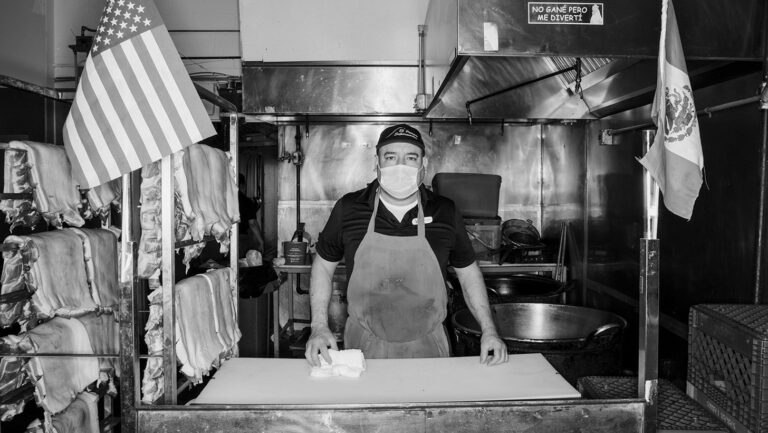Posing as a man, rather than actually behaving like one, is all that's left for a great many American males, our president included. An exhibit of mixed media work currently running at Galerie E explores this theme in grotesque detail.
Patrick Nagatani, a professor in the Department of Art and Art History at UNM, has exhibited his work all over the world. His art often incorporates brutal political or social themes, and the mixed media pieces in Unimaginable Weight are no exception.
From a distance Nagatani's photo collages, which make up the bulk of the work in this show, look like clumps of melted red and brown wax. At close range, it's startling to discover that they contain images of bodies, of both men and women, dressed in skimpy swimwear, their flesh swollen with obsessive exercise and steroids.
“Thrust” and “Air-to-Air” incorporate the same collage, each depicting faceless muscle-bound men with different kinds of rockets lined in a row at the bottom of the piece. “Roles” depicts exclusively buffed-out Black men. This time, though, a row of tiny plastic figurines of Black men dressed as musicians, athletes, waiters, businessmen and Muslims occupies the bottom row.
A fourth piece, “Today,” stands apart from the rest of the exhibit. This piece is smaller and doesn't consist of a photo collage. Instead it's an “advertisement” depicting soldiers with rifles, walkie-talkies, parachutes and war planes, which reads: “In today's world … What does it take to feel like a man?”
That question is at the center of the whole exhibit. The answer Nagatani offers is deeply disturbing, suggesting that not only physical appearance and occupation defines a man, but also mankind's undeniable lust for violence.
Nagatani's exploration of gender identity is just as horrifying in his pieces focusing on women. “Measure” and “Placebo” incorporate the same collage depicting women with inflated masculine bodies. No faces are visible, only bodies, reducing these women to hunks of meat in a butcher shop. In “Measure,” white numbered pills are suspended in a row at the bottom of the image. In “Placebo,” pill capsules of different colors, four of which contain tiny plastic figures of men in suits, occupy the bottom row.
“Contest” and “Mystique” likewise incorporate the same collage of faceless muscled women. At the center of both these pieces is a picture of a grinning '50s-style mom holding a tape measure. “Contest” displays a red second place ribbon at its center with rows of red, white and blue pills at the bottom. “Mystique” includes a row of tiny figurines of women in bikinis, underwear, naked or undressing. In “MOAB,” Nagatani twists his theme, depicting animated glorifications of muscle-bound women in superhero costumes collaged together with green phallic missiles, tips like nipples, at the bottom.
Taken all together, these pieces suggest that a woman can only achieve fulfillment by being a stereotypical '50s-era mom, a superhero, a slut or by pretending she's a man. And even when women succeed in occupying these roles, Nagatani implies they will always be the second place gender.
Nagatani's work in this show communicates the unimaginable weight born by contemporary boys and girls. His art shows how people struggle to establish functional identities in our modern industrialized, militarized, chemicalized society. It's a socially incisive, if somewhat nightmarish, exhibit by one of our very best local artists.
Unimaginable Weight, an exhibit featuring mixed media work by Patrick Nagatani, runs through August 12 at Galerie E (upstairs in the Mariposa Gallery). 268-6828.








